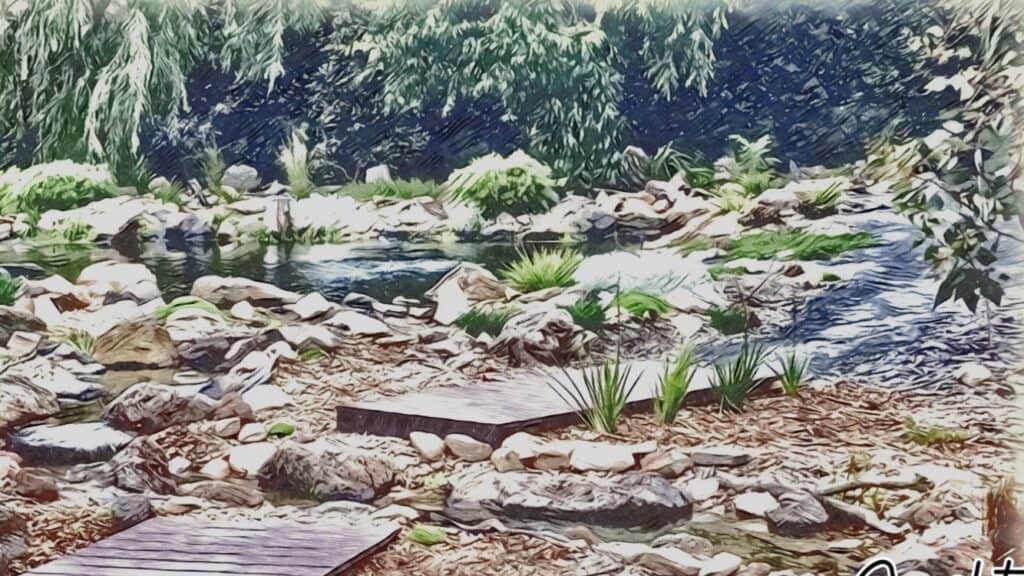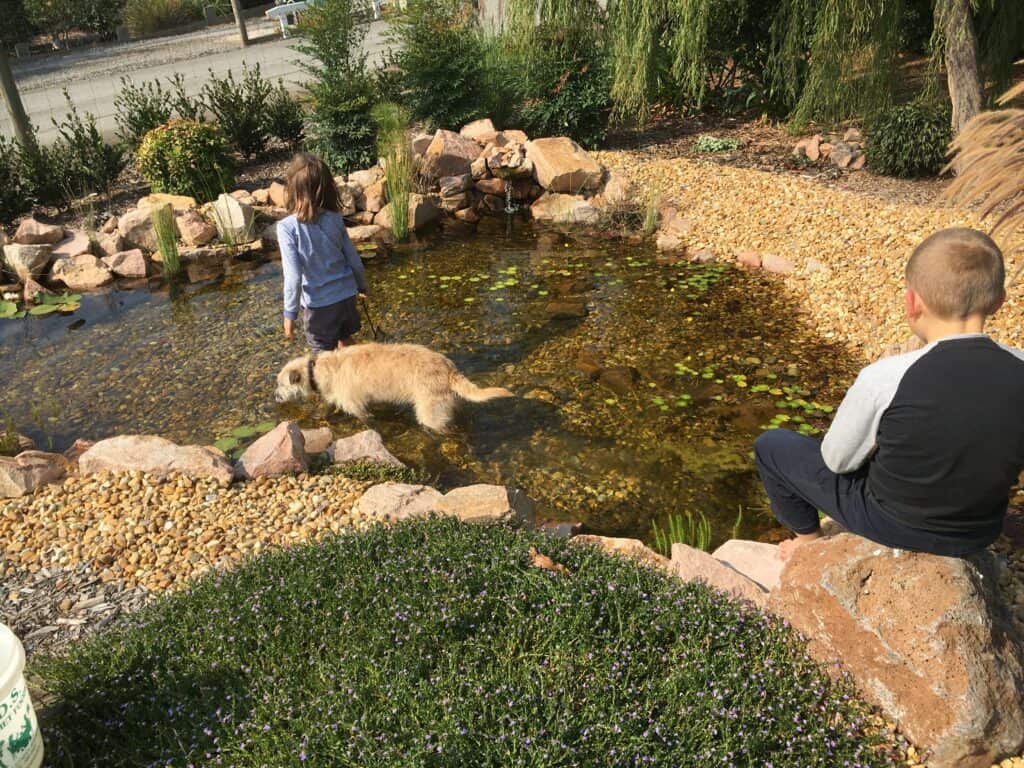Adding rocks and gravel to a pond can be a contentious issue.
Many specialist koi ponds will never add rocks and gravel directly to their ponds.
However the vast majority of pond owners are just looking to keep some cool fish.
Not everyone wants to showcase thousand dollar koi.
So if like me you just want to keep a few fish, create a natural looking haven and a low maintenance pond I believe in adding rocks and pebbles to the pond.

Need help designing your pond? Looking for affordable pond products?
I’ve assembled a list and helpful links to the products I use when building my ponds.
If you want to check it out click the button below.
1. Clean, clear water
Every pond needs to have nitrifying bacteria. Without the bacteria the pond doesn’t function.
Bacteria process harmful compounds in the water. Fish secrete ammonia. Ammonia is toxic to fish and it is also a food source for algae.
There are many stages to the process. Its called the nitrogen cycle and every pond owner should be aware how this process works.
If you have never heard of the nitrogen cycle please take the time to read my quick guide to the nitrogen cycle article or watch this short video.
So the bacteria that are responsible for the nitrogen cycle colonise every wet surface in the pond.
More surface area = more bacteria
In a pond with a bare liner bottom there is much less surface area than a pond with rocks and pebbles.
The argument goes that its easier to clean a bare bottom pond.
But the reason it needs to be cleaned all the time is because there isn’t enough bacteria in the pond to process all the muck.
In a bare bottomed pond it’s important that you need to add more external filtration than a rock and gravel pond.
There are many different types of filters. But they all have one thing in common.
They provide a home for bacteria to grow!
I believe the best type of filter you can add to any pond is a bog filter.
And guess what… it uses rocks and gravel to provide plenty of surface area to house all that good nitrifying bacteria.
Here is a short video showing a small pond i created with bare liner. I thought i had enough surfaces for the bacteria.
I was wrong the water went green!
If you want to learn more about bog filters you can read my bog filter overview article.
2. Protect the liner
There are quite a lot of different liners that are available.
Not all liners are created equal. You do get what you pay for!
If you haven’t yet purchased a pond liner or shell you might want to take a look at my article on pond liner choices.
So first up adding rocks and gravel will protect the liner from ultra toilet light.
If you buy a good quality pond liner it will be uv stabilised and guaranteed for a certain number of years.
But by blocking out the light you will be extending the life of the liner.
Secondly rocks and gravel will provide a barrier.
Things are going to get in the pond!
At my house it’s me, the kids and the dog. We are always into the ponds seeing what we can find.
Having that protective layer of rocks and gravel over the liner protects it from sharp claws, sticks, ect.

3. Looks more natural
This is pretty self explanatory a pond with plants, rocks and gravel blends more naturally into the landscape.
Having large rocks and small gravel makes it easy to hide filter components.
I don’t want to see the pump, the skimmer or any biological filtration units.
It adds a sense of mystery. Where is this water coming from?
4. Growing plants
In a bare bottomed pond plants need to be placed into pots.
A pond with rocks and gravel we can create planting pockets.
This allows us to complete remove all soil from the plants. The roots will grow into the gravel.
As the plants seek out nutrients they will outcompete algae.
Adding soil or potting mix into the pond (via pots) will introduce extra nutrients.
Algae is very fast growing the second there is excess nutrients it will start growing.
5. Hiding spots and exercise for the fish
Lastly adding rocks and gravel lets you create caves or even tunnels for the fish.
Eventually every pond owner is going to encounter predators. You really need to have those hiding areas in place to give your fish a sporting chance.
The smaller gravel on the bottom provides homes for tons of micro-organisms.
Fish will spend ours scouring the gravel in search of food.
This will help provide them with a more balanced diet and a good source of exercise.
Again this is just trying to replicate a more natural feel for both you and the fish.
When you wouldn’t add pebbles to your pond
As I mentioned the majority of pond owners who don’t want pebbles in their pond are serious koi keepers. Koi fish can be incredibly expensive and serious collectors will spend a pretty penny on the right fish.
When you are spending so much money on fish their health is paramount. Keeping the area in which the fish live as clean as possible is seen as the optimal way to keep them safe from parasites and diseases.
These kinds of ponds are often designed with bottom drains and large external mechanical and biological filtration units. Even better the use of large bog or wetland filters.
The bottom drains allow for any solids like fish waste, uneaten food and sunken plant materials to be easily drained from the pond. These organic materials will affect the water quality if allowed to build up.
Meanwhile the filtration units (seperate from the pond) wether large drum filters or a bog/ wetland filter are providing a home for billions of beneficial bacteria and microorganisms. These are keeping the nitrogen cycle running smooth and water quality pristine.
If your unsure about what the nitrogen cycle is you should read our article a quick guide to the nitrogen cycle. Every pond or fish keeper needs to understand how the cycle works so they can keep it running.
When you should add pebbles to your pond
As you now know the biggest benefit of having pebbles, rocks and gravel in your pond is that these surfaces provide the perfect home for beneficial bacteria and micro-organisms. By allowing the bacteria and micro-organisms habitat within the pond it reduces the area or requirement for large external filters.
Having the bacteria and micro-organisms living in large numbers within the pond itself can greatly help you in keeping the water crystal clear and healthy.
The rocks and pebbles gives you areas where you can plant water loving plants. Water plants will consume excess nutrients within the water. Removing these will greatly help keep algae to a minimum.
Also rocks can provide plenty of nooks and crannies where fish can hide from predatory birds and animals. The rocks coupled with the plants provide excellent habitats for the fish to spawn and the baby fry to thrive.
In a specialised koi pond without pebbles the organic solids needed to be removed. In a more natural pond the organic material is consumed by the bacteria and organisms living on the pebbles and gravel.
Of course it’s still incredibly wise to add a pond skimmer to any pond to remove leaf debris and uneaten food. Then a simple waterfall filter or bog filter can process the fish waste that the pump sucks up.
These types of ponds can look incredibly natural and are very low maintenance.
Conclusion
There is no right or wrong answer. Both pond types can provide a safe and healthy environment for your pond fish or other pond creatures.
Both are using beneficial bacteria and organisms to help process waste and keep the water healthy.
The pebble free pond requires slightly more maintenance, but it’s also quite likely going to be stocked with more fish.
The pebble and rock pond is more attuned with nature and less work, but from time to time may need a large scale clean out.
The choice is yours.
In my option if your going for a more formal straight line pond that’s purely for fish going pebble free is a fine choice. Incorporating a bog or wetland filter will allow you to still have some beautiful plants and provide ample room for beneficial bacteria.
If this type of pond appeals to you check out sizing a bog filter so you provide adequate filtration.
For those after a more natural look and lower weekly maintenance create a pond that’s a more well rounded ecosystem and incorporates pebbles, rocks and gravel.
Subscribe
If you haven’t already, you’ll want to subscribe to our mailing list. From time to time pond equipment suppliers and contractors contact me with special offers and discounts.
I love saving you guys money!!
So if you’d like to receive these special offers go ahead and use the button below to sign up.

